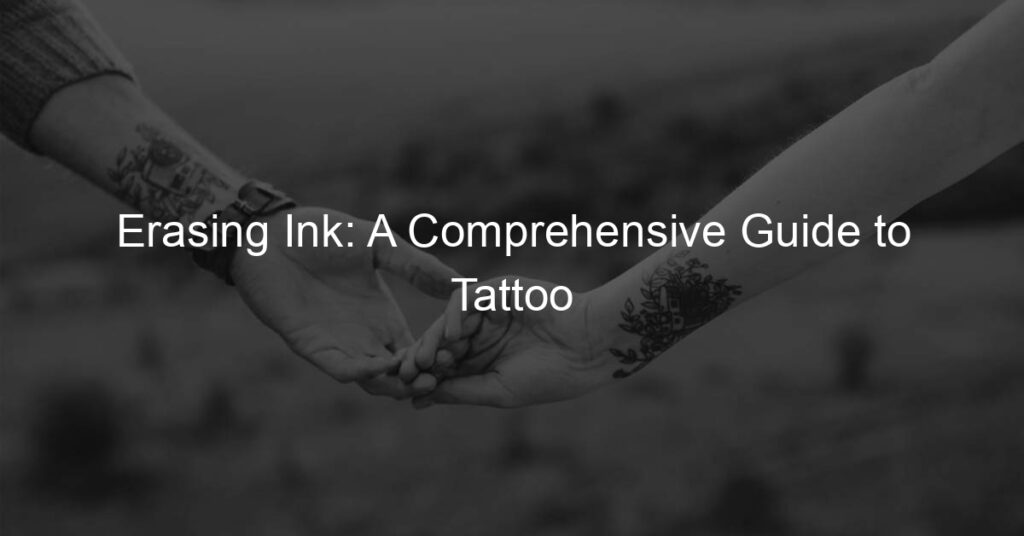
Introduction to Tattoo Removal
Getting a tattoo can be an exciting experience, a way to express yourself, or a symbol of a significant life event. However, as time passes, some people may come to regret their decision. This is where tattoo removal comes into play. In this section, we will explore why people choose to remove their tattoos and provide a brief overview of the tattoo removal process.
-
- Understanding the Need for Tattoo Removal
There are many reasons why someone might want to remove a tattoo. Perhaps the tattoo no longer represents who they are, or it was a spontaneous decision that they now regret. Some people may need to remove a tattoo for professional reasons, as certain jobs have strict policies regarding visible tattoos. Others may simply want to make room for new artwork. Regardless of the reason, it’s important to understand that tattoo removal is a personal decision and should be respected as such.
-
- Overview of the Tattoo Removal Process
The process of tattoo removal involves breaking down the tattoo ink that is embedded in the skin. This is typically done using laser technology. The laser targets the ink particles, breaking them down into smaller fragments. These fragments are then naturally eliminated by the body’s immune system. It’s important to note that tattoo removal is not a one-time process. It requires multiple sessions, depending on the size, color, and location of the tattoo, as well as the individual’s skin type.
In the following sections, we will delve deeper into the different methods of tattoo removal, the cost, the risks and safety measures, the pain management, the healing process, and professional tattoo removal. We hope this information will help you make an informed decision about whether tattoo removal is the right choice for you.
Tattoo Removal Methods
There are several methods to remove tattoos, but one of the most effective and popular ones is laser tattoo removal. Let’s delve into how this method works, the types of lasers used, and what you can expect before and after the procedure.
Laser Tattoo Removal
Laser tattoo removal is a modern method that uses advanced technology to break down the tattoo ink in your skin. This method is known for its precision and effectiveness.
-
- How laser tattoo removal works
Laser tattoo removal works by using a high-intensity light beam to break down the ink particles in the tattoo. The laser targets the ink with pulses of highly concentrated light that shatter the ink into tiny fragments. These fragments are then cleared away by your body’s immune system over several weeks or months following the treatment.
-
- Types of lasers used
There are several types of lasers used in tattoo removal, but the most common are Q-switched lasers. These lasers can produce a high amount of power in a very short pulse, making them ideal for shattering tattoo ink without damaging the surrounding skin. Other types of lasers used include the PicoSure, PicoWay, and RevLite lasers.
-
- Tattoo Removal Before and After: Laser method
Before the procedure, your skin specialist will guide you through the process and prepare your skin for treatment. This may involve applying a topical anesthetic to numb the area. During the procedure, you’ll wear protective eye shields and a laser will be used to pass pulses of intense light through the top layers of your skin to be absorbed by the tattoo ink.
After the procedure, you may experience some redness, swelling, and minor discomfort. However, these symptoms should subside within a few days. It’s important to follow your specialist’s aftercare instructions to ensure the best results and minimize the risk of side effects.
Remember, laser tattoo removal requires multiple sessions to achieve the best results. The number of sessions needed will depend on the size, color, and location of your tattoo. Always consult with a professional to understand what you can expect from the process.
Tattoo Removal Creams
Another method to consider in the journey of tattoo removal is the use of creams. Let’s delve into how these creams work, their effectiveness, and what you can expect before and after using them.
-
How Tattoo Removal Creams Work
Tattoo removal creams are topical solutions that you apply directly to the tattooed skin. They work by penetrating the skin layers and breaking down the tattoo ink. The body’s immune system then helps to flush out the broken-down ink. It’s a process that requires patience, as it can take several months to see significant results.
-
Effectiveness of Tattoo Removal Creams
It’s important to note that the effectiveness of tattoo removal creams varies. Factors such as the size, color, and age of the tattoo, as well as the depth of the ink in your skin, can all influence the outcome. Some people may see a noticeable lightening of their tattoo, while others may see little to no change. It’s also worth noting that no tattoo removal cream can guarantee complete removal of a tattoo.
-
Tattoo Removal Before and After: Cream Method
Before starting the cream method, it’s essential to have realistic expectations. As mentioned, the results can vary widely. After consistent use over several months, you may notice your tattoo becoming lighter, but it’s unlikely to disappear completely. Here’s a simple table to illustrate what you can expect:
Before Using Cream After Using Cream Visible, vibrant tattoo Lighter, less vibrant tattoo
In conclusion, tattoo removal creams can be a less invasive option for those looking to lighten their tattoos. However, they may not be as effective as other methods like laser tattoo removal. Always consult with a professional before starting any tattoo removal process.
Tattoo Removal Cost
When it comes to removing a tattoo, one of the primary considerations is the cost. The price can vary significantly based on several factors. In this section, we will delve into the factors that influence the cost of tattoo removal and compare the costs of two popular methods: laser and creams.
-
- Factors influencing the cost of tattoo removal
Several factors can affect the cost of tattoo removal. These include the size of the tattoo, the colors used, the location on the body, and the type of removal method chosen. Let’s break down these factors:
-
-
- Size: Larger tattoos require more time and resources to remove, hence they are typically more expensive to remove than smaller ones.
- Colors: Different colors require different types of lasers for removal. Tattoos with multiple colors may cost more to remove as they may require the use of multiple lasers.
- Location: Tattoos located on areas with thinner skin or near bones may be more difficult and costly to remove.
- Type of removal method: The method chosen for tattoo removal also significantly impacts the cost. Laser removal is generally more expensive than other methods, such as tattoo removal creams.
- Comparing costs: Laser vs Creams
-
There are several methods available for removing tattoos, but the most common ones are laser removal and tattoo removal creams. Here’s a comparison of their costs:
| Method | Average Cost |
|---|---|
| Laser Tattoo Removal | $200-$500 per session |
| Tattoo Removal Creams | $100-$200 per bottle |
As you can see, laser tattoo removal is generally more expensive than tattoo removal creams. However, it’s important to note that laser removal is often more effective and faster. Creams, on the other hand, are less invasive but may take longer to show results and may not be as effective on larger or more colorful tattoos.
In conclusion, the cost of tattoo removal can vary greatly depending on several factors. It’s important to consider these factors and consult with a professional to get an accurate estimate of the cost for your specific tattoo.
Tattoo Removal Risks and Safety
When deciding to remove a tattoo, it’s crucial to understand the potential risks and safety measures associated with the process. This section will discuss the potential risks of laser tattoo removal, tattoo removal creams, and the safety measures to consider.
- Potential risks of laser tattoo removal
Laser tattoo removal is a popular method due to its effectiveness. However, it’s not without risks. Some people may experience side effects such as skin discoloration, infection, or scarring. In rare cases, the laser may not completely remove the tattoo, leaving a ghost image. It’s also important to note that different colors of ink respond differently to the laser, which can affect the removal process.
- Potential risks of tattoo removal creams
Tattoo removal creams offer a less invasive alternative to laser removal. However, they also come with potential risks. Some creams contain harsh chemicals that can cause skin irritation, burns, or even permanent skin damage. Furthermore, these creams often don’t fully remove the tattoo, leading to uneven fading or discoloration.
- Safety measures to consider
Regardless of the method you choose for tattoo removal, safety should be your top priority. Always consult with a professional before starting any treatment. Make sure the facility is clean and the staff is trained and certified. Follow all aftercare instructions to prevent infection and promote healing. Lastly, understand that tattoo removal is a process that requires patience and multiple treatments.
In conclusion, while tattoo removal can help you erase unwanted ink, it’s important to be aware of the potential risks and safety measures. By doing your research and consulting with professionals, you can make an informed decision that’s best for you.
Tattoo Removal Process
Understanding the tattoo removal process can help you make an informed decision. The process typically involves four main steps: consultation, preparation, treatment, and aftercare. Let’s break down each step:
- Consultation
The first step in the tattoo removal process is a consultation with a professional. During this meeting, the professional will examine your tattoo, discuss your removal goals, and explain the process in detail. They will also answer any questions you may have. This step is crucial as it helps set realistic expectations for the outcome of the procedure.
- Preparation
Once you decide to proceed, the next step is preparation. This may involve cleaning the tattoo area and applying a numbing cream to minimize discomfort during the procedure. The professional will also provide you with instructions on what to do and what to avoid before your treatment session.
- Treatment
The treatment phase is when the actual tattoo removal happens. The professional uses a special laser that breaks down the tattoo ink into tiny particles. These particles are then naturally eliminated by your body. The number of treatment sessions you’ll need depends on the size, color, and age of your tattoo.
- Aftercare
Aftercare is an essential part of the tattoo removal process. Proper care of the treated area can help speed up healing and reduce the risk of side effects. This usually involves keeping the area clean, applying prescribed ointments, and avoiding sun exposure.
In conclusion, the tattoo removal process involves a series of steps, each crucial to achieving the best results. By understanding what each step entails, you can better prepare for your tattoo removal journey.
Tattoo Removal Pain and Management
When it comes to tattoo removal, one of the most common concerns is the pain associated with the process. While everyone’s pain tolerance is different, understanding what to expect can help you better prepare for your tattoo removal session.
-
- Understanding the pain associated with tattoo removal
It’s important to note that tattoo removal isn’t a pain-free process. Many people compare the sensation to a rubber band being snapped against the skin. The discomfort is often described as moderate to high, depending on the location and size of the tattoo. The pain is usually most intense during the procedure and lessens afterward.
Factors that can influence the level of pain include the location of the tattoo, the size and color of the tattoo, and your personal pain tolerance. Tattoos located on areas with thinner skin, such as the ankles or wrists, are typically more painful to remove than those on fleshy areas like the arms or thighs.
-
- Methods to manage tattoo removal pain
Fortunately, there are several methods to manage the pain associated with tattoo removal. The most common method is the use of a local anesthetic to numb the area. This can significantly reduce the discomfort during the procedure.
Over-the-counter pain relievers can also be taken before the procedure to help manage the pain. However, it’s important to discuss this with your doctor first, as some medications can increase the risk of bleeding.
Other methods include using a cooling device during the procedure to numb the skin, or practicing deep breathing techniques to help distract from the pain. After the procedure, applying a cold compress can help to reduce any swelling and discomfort.
In conclusion, while tattoo removal can be uncomfortable, understanding the pain involved and knowing how to manage it can make the process much more bearable. It’s important to discuss any concerns with your doctor, who can provide further advice and options for pain management.
Tattoo Removal Healing Process
After you’ve undergone a tattoo removal procedure, it’s essential to understand the healing process that follows. This process is crucial to ensure the success of the treatment and to prevent any complications. Let’s delve into what you can expect during this period and tips for a smooth healing process.
- What to expect during the healing process
Following a tattoo removal procedure, your skin will need time to heal. The healing process can vary from person to person, but generally, it involves several stages:
- Initial Healing: In the first few days after the procedure, you may experience redness, swelling, and a slight burning sensation. This is a normal reaction as your body starts to heal.
- Scab Formation: After about a week, scabs may form over the treated area. It’s important not to pick at these scabs as they are part of the healing process.
- Scab Healing: The scabs will eventually fall off naturally, revealing new skin underneath. This process can take 1-2 weeks.
- Final Healing: Over the next few weeks, your skin will continue to heal and regenerate. The tattoo should start to fade during this time.
- Tips for a smooth healing process
Proper care during the healing process can help ensure a successful tattoo removal. Here are some tips:
- Follow Aftercare Instructions: Your healthcare provider will give you specific aftercare instructions. It’s crucial to follow these to prevent infection and promote healing.
- Stay Hydrated: Drinking plenty of water can help your body heal faster.
- Avoid Sun Exposure: The treated area will be sensitive to the sun, so it’s best to keep it covered or apply a high SPF sunscreen.
- Don’t Pick at Scabs: As tempting as it may be, picking at scabs can lead to scarring. Let them fall off naturally.
In conclusion, understanding the tattoo removal healing process and following the right aftercare procedures can help ensure a successful outcome. Remember, everyone’s body heals at a different pace, so be patient with yourself during this time.
Professional Tattoo Removal
When it comes to getting rid of an unwanted tattoo, professional tattoo removal is the safest and most effective option. Let’s explore the benefits of professional tattoo removal and how to choose the right professional for the job.
-
- Benefits of Professional Tattoo Removal
Professional tattoo removal offers several advantages over DIY methods. Here are some of the key benefits:
-
-
- Safe and Effective: Professional tattoo removal uses advanced technology to break down the tattoo ink in your skin without causing harm to the surrounding tissue. This makes it a safe and effective method for tattoo removal.
- Less Scarring: Because professional tattoo removal targets only the tattoo ink, it significantly reduces the risk of scarring compared to other methods.
- Complete Removal: While DIY methods may only fade the tattoo, professional tattoo removal can often completely remove the tattoo, leaving your skin as it was before the tattoo.
- Choosing the Right Professional for Tattoo Removal
-
Choosing the right professional for your tattoo removal is crucial to ensure a safe and effective procedure. Here are some factors to consider:
-
- Experience and Qualifications: Look for a professional who has extensive experience and the necessary qualifications in tattoo removal. They should be able to provide you with before and after photos of their previous work.
- Technology: The professional should use the latest tattoo removal technology to ensure the best results.
- Consultation: A good professional will offer a consultation before the procedure to discuss your specific needs and expectations. They should also provide you with detailed information about the procedure and aftercare.
In conclusion, professional tattoo removal offers a safe and effective way to get rid of unwanted tattoos. However, it’s important to choose the right professional to ensure the best results. Always do your research and ask plenty of questions before deciding on a professional for your tattoo removal.
Conclusion: Making the Decision
Deciding to remove a tattoo is a significant step. It’s important to consider all the factors we’ve discussed in this article. Let’s summarize the key takeaways and look at a case study of a successful tattoo removal.
-
- Key Takeaways
Here are the most important points to remember:
-
-
- Tattoo removal is a process that requires multiple sessions.
- There are different methods of tattoo removal, each with its own advantages and disadvantages.
- The cost of tattoo removal varies depending on the size, color, and location of the tattoo, as well as the method used.
- There are risks involved in tattoo removal, including infection and scarring, but these can be managed with proper care and professional guidance.
- The pain of tattoo removal can be managed with numbing creams and painkillers.
- The healing process after each session is crucial for the success of the treatment.
- Professional tattoo removal is the safest and most effective option.
- Case Study: Successful Tattoo Removal
-
Let’s look at a real-life example of successful tattoo removal. John, a 30-year-old man, decided to remove a tattoo he got when he was 18. The tattoo was a large, colorful design on his arm. He chose a professional clinic for the procedure and underwent laser tattoo removal.
John attended multiple sessions over a period of six months. He experienced some pain during the procedures, but it was manageable with numbing cream and over-the-counter painkillers. He followed the aftercare instructions carefully, which included keeping the area clean and applying a healing ointment.
After six months, the tattoo was completely gone. John was very happy with the results and felt that the time, effort, and cost were worth it to remove a tattoo he no longer wanted.
In conclusion, tattoo removal is a serious decision that requires careful consideration. By understanding the process, costs, risks, and healing involved, you can make an informed decision that’s right for you.






